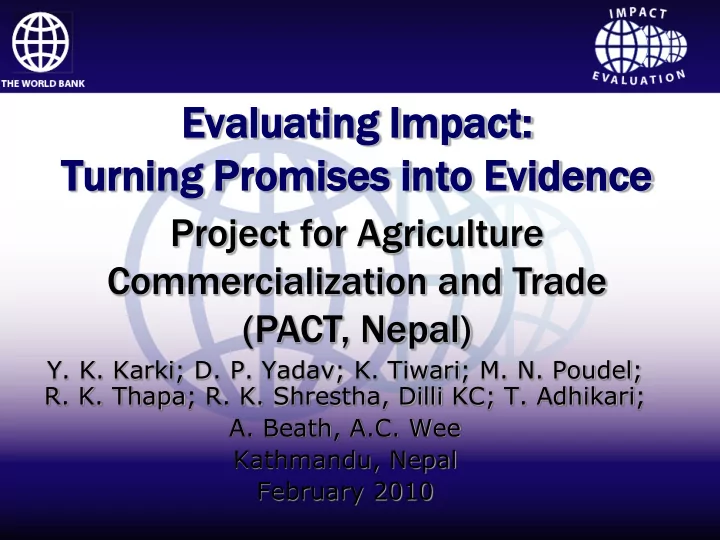

Ev Evaluating aluating Im Impact: act: Tu Turning ning Promises omises in into to Ev Evid idence ence Project for Agriculture Commercialization and Trade (PACT, Nepal) Y. K. Karki; D. P. Yadav; K. Tiwari; M. N. Poudel; R. K. Thapa; R. K. Shrestha, Dilli KC; T. Adhikari; A. Beath, A.C. Wee Kathmandu, Nepal February 2010
1. Background Project seeks to improve the competitiveness of smallholder farmers and the agribusiness sector in selected commodity value chains. Components: Agriculture and Rural Business 1. Development; Support for Sanitary and Phytosanitary 2. Facilities and Food Quality Management; Project Management and Monitoring and 3. Evaluation. 2
2. Results Chain Long-term Inputs Activities Outputs Outcomes Outcomes • $6 million; • Assist value- • Grants awarded • Increased • Improve chain participants to successful productivity of nutritional status • 20 staff & 20 in formulating applicants (value select commodities; of villagers in consultants; proposals and chain affected areas; • Increased select recipients participants) for production of select • Reduce incidence to receive grants sub-projects in commodities; of poverty among for value chain technology and value chain development infrastructure • Increase sales participants; volume of select commodities • Increase income of value chain participants 3
3. Primary Research Questions What is impact of grants on: use of new agricultural technologies?; agricultural productivity and production?; commercialization of agriculture?; income levels and poverty of recipients? 4
4. Outcome Indicators Production, productivity and sales volume of basket of ~20 high-value crops; Use of new technology in production and processing; Diversification of crops under cultivation; Share of output exported; Profit margin of value chain participants; Income of value chain participants; 5
5. Identification Strategy/Method Intervention : grants to qualified applicants in various sectors (thematic areas); Treatment Group : grant recipients; Control Group : unsuccessful eligible applicants; Assignment Mechanism : randomly select 140 successful applicants from 280 top-scoring applicants; 6
6. Sample and data Sample : 280 top-scoring grant applicants; Survey Structure : per group applicant interview (10 farmers, 3 traders, 2 processors, and 10 randomly-selected villagers); and focus group discussion (cooperatives for individual applicants, individual interview of applicant); Data Collection Timeline : Baseline survey: A4 top 280 scoring applications are identified (but B4 selection of grant recipients); Mid-term follow-up survey: 2 years A4 grant receipt; Final follow-up survey: 4 years A4 grant receipt. 7
7. Time Frame/Work Plan Activity Time Recruitment of Principal October 2010 Investigator and team Delivery of Inception January 2011 Report Admin. of Baseline Survey April - July 2011 Midterm Followup Survey June 2013 Final Follow-Up Survey, 2015-16 Analysis & Dissemination 8
8. Sources of Financing Principal Investigator & Consultants : DIME, SIEF, WB TFs, & Academic Funding. Survey Costs : Project M&E Budget Thank you for your kind attention. 9
Recommend
More recommend